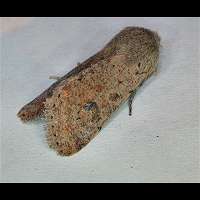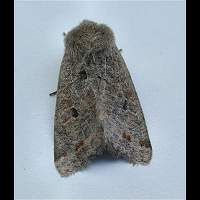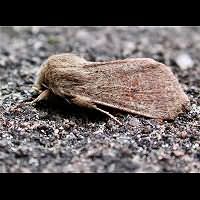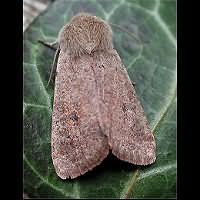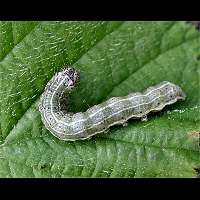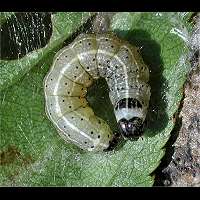Small Quaker Orthosia cruda
The Small Quaker wears its name with pride, for it is the smallest of all Quakers and Drabs. The size makes it easy to identify this species. The markings present you with problems, for this species is variably marked. Usually only the kidney mark is clearly visible. The circular mark usually is vaguely visible, but it may be absent. There may be some lines running over the wings, but often these are reduced to a couple of black dots or completely absent. The grondcolour is light brown, sometimes more of a reddish brown, sometimes tending to greyish brown. The wingspan varies between 28 and 32mm.
The eggs are being laid in spring in small groups. Often they hatch within a week. The caterpillars eat by night and hide by day between leaves spun together. The caterpillar can be extremely cannibalistic, at least in confinement. In July the caterpillars move to the ground, go underground, weave a thin cocoon and pupate. It is the pupa overwintering. Usually the basic colour of the caterpillar is blueish green, even though occassionally brown animals may be encountered. Each segment of the body has some ten small black dots. Three white lines run over the body from head to tail on the back and sides. There is a white band around the 11th segment. Especially in the last stage there is a black marking on the first segment just behind the head. The head is of the same colour as the body, but has black markings. The head becomes more black with aging. The caterpillar grows to a length of 25 to 30mm. Foodplants often mentioned are oak, hawthorn, hazel, rose and sallow. But the caterpillar of the Small Quaker has been found on other trees and shrubs too.
The period the Small Quaker is on the wing is typical for the entire group of Quakers and Drabs: March and April mainly. It flies by night only. The main source of food for the adult moths are catkins. The adults are easily attracted to both light and sugar. Animals caught at night are good models for photographers the next day. When doing it gently they even permit you to manipulate them. Not an uncommon species in England and Wales. Less common in Scotland and Ireland. Quite common on most of the European Continent.
The Small Quaker wears its name with pride, for it is the smallest of all Quakers and Drabs. The size makes it easy to identify this species. The markings present you with problems, for this species is variably marked. Usually only the kidney mark is clearly visible. The circular mark usually is vaguely visible, but it may be absent. There may be some lines running over the wings, but often these are reduced to a couple of black dots or completely absent. The grondcolour is light brown, sometimes more of a reddish brown, sometimes tending to greyish brown. The wingspan varies between 28 and 32mm.
The eggs are being laid in spring in small groups. Often they hatch within a week. The caterpillars eat by night and hide by day between leaves spun together. The caterpillar can be extremely cannibalistic, at least in confinement. In July the caterpillars move to the ground, go underground, weave a thin cocoon and pupate. It is the pupa overwintering. Usually the basic colour of the caterpillar is blueish green, even though occassionally brown animals may be encountered. Each segment of the body has some ten small black dots. Three white lines run over the body from head to tail on the back and sides. There is a white band around the 11th segment. Especially in the last stage there is a black marking on the first segment just behind the head. The head is of the same colour as the body, but has black markings. The head becomes more black with aging. The caterpillar grows to a length of 25 to 30mm. Foodplants often mentioned are oak, hawthorn, hazel, rose and sallow. But the caterpillar of the Small Quaker has been found on other trees and shrubs too.
The period the Small Quaker is on the wing is typical for the entire group of Quakers and Drabs: March and April mainly. It flies by night only. The main source of food for the adult moths are catkins. The adults are easily attracted to both light and sugar. Animals caught at night are good models for photographers the next day. When doing it gently they even permit you to manipulate them. Not an uncommon species in England and Wales. Less common in Scotland and Ireland. Quite common on most of the European Continent.

